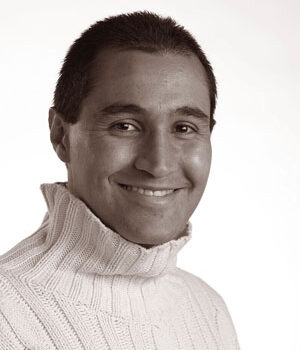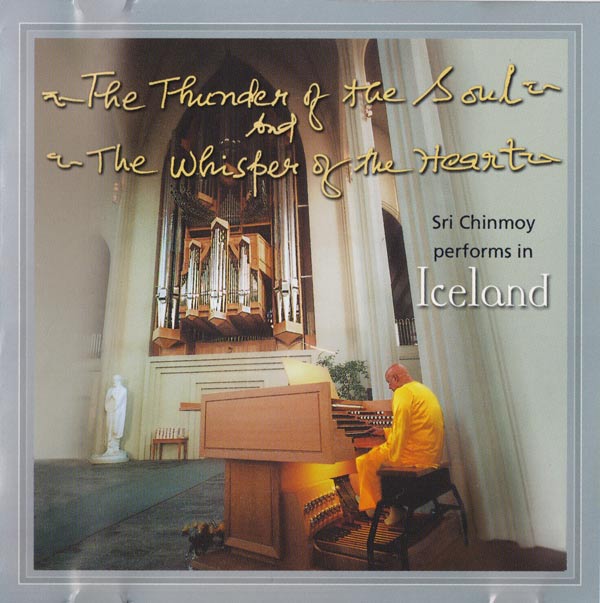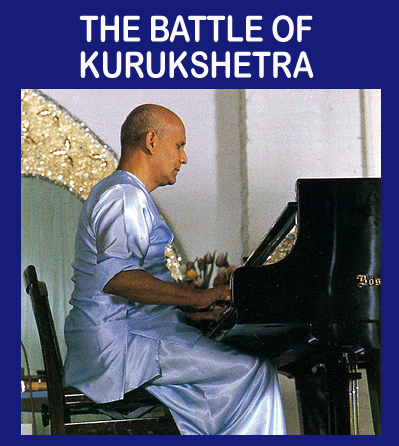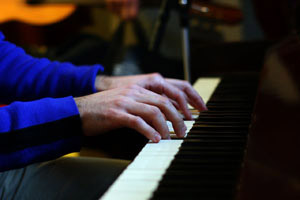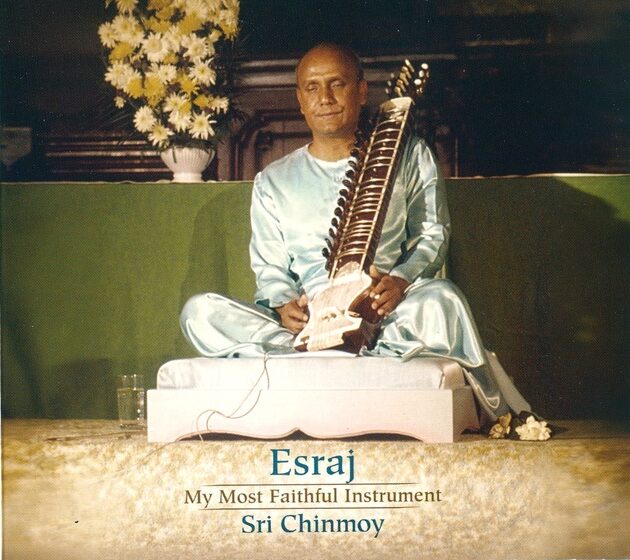In this piece, Hridananda utilizes a few of Sri Chinmoy‘s melodies as part of the thematic material. Sri Chinmoy’s melodies are interwoven in the fabric of each movement. Here are Hridananda’s notes on A Sadhak’s Tale:
Hridananda Andrés Ramón
A Sadhak’s Tale
for Chamber Orchestra
Instrumentation:
Piccolo Flute
Flute
Oboe
Clarinet
Bassoon
French Horn in F
Percussion
Soprano
Percussion
Piano
Violin I
Violin II
Viola
Violoncello
Double-Bass
Some considerations on A Sadhak’s Tale:
A Sadhak’s Tale is a piece composed in the spirit of programme music and reflects the composer’s interest in Indian spiritual literature and philosophy, that is, Vedanta philosophy. The work is based on an original plot that draws its inspiration from the writings of several Indian thinkers and authors from the last hundred years, particularly from the works of Rabindranath Tagore (1861-1941), Sri Aurobindo (1872-1950) and Sri Chinmoy (1931-2007).
The plot deals with the life of a spiritual seeker according to Vedanta philosophy, which considers human existence on earth to be an invaluable opportunity to make spiritual progress up to the extent of finding the divinity within ourselves and manifesting it in our material reality. The human soul is considered to be a reflection of Divinity, which comes once and again into the world through countless incarnations in order to reveal this inherent Divine essence.
According to Vedanta philosophy, one of the most fruitful ways in order to uncover and manifest our Divinity is through yogic discipline. In Sanskrit, an ancient Indian language, the practice of yoga is called sadhana. A person who becomes aware of the spiritual purpose of his or her existence and follows his or her spiritual aspiration in a conscious way through the practice of yoga, especially under the guidance of a spiritual master or guru, is called a sadhak (a person who practices a sadhana). The main character in A Sahak’s Tale is such an individual or sadhak who has decided to follow a path of spiritual practice after having realised the emptiness of living a merely material and intellectual existence.
A Sadhak’s Tale is divided into thirteen movements (one of them being subdivided into two parts), where each movement reflects a particular aspect of the spiritual quest or sadhana according to Vedanta philosophy, from birth until death and beyond physical death. The form of the piece is symmetrical, as the seventh movement acts as the axis and turning point of the story; 6 movements precede it and 6 others succeed it. It is in this seventh movement when the individual (the sadhak) finally realises the importance of embarking upon a spiritual search
in the guise of Indian yoga practice.
The piece’s musical language reflects the story’s plot and is primarily based on melodic lines in various arrangements. Most of the melodies were adopted from the compositions of the Indian musician and spiritual master Sri Chinmoy, and are arranged for diverse instruments and in various musical styles. Some movements correspond to the European classical tradition regarding instrumentation, harmonisation and texture, while others evoke traits of world music, particularly of Indian and South American ethnic music. For that purpose, motives, ostinato lines, rhythms and percussion instruments are of great importance, as a great number of percussion instruments from various cultural traditions are being employed. Throughout the work there is a combination of slow and fast movements that are either meditative or dynamic in character, for which purpose a great amount of time signatures (both regular and compound) are used. The influence of jazz and improvised music is also evident in the use of rhythmic elements and solo sections for improvisation.
A Sadhak’s Tale
1. Beginnings: The Higher Worlds.
Narrator:
It was the hour before the Gods awake.
Across the path of the divine Event
The huge foreboding mind of Night, alone
In her unlit temple of eternity,
Lay stretched immobile upon Silence’ marge.
Almost one felt, opaque, impenetrable,
In the sombre symbol of her eyeless muse
The abysm of the unbodied Infinite;
A fathomless zero occupied the world.
A power of fallen boundless self awake
Between the first and the last Nothingness,
Recalling the tenebrous womb from which it came,
Turned from the insoluble mystery of birth
And the tardy process of mortality
And longed to reach its end in vacant Nought.
2. Birth: A New Hope.
Sadhak:
Thou hast made me endless, such is thy pleasure. This frail vessel thou emptiest again and again, and fillest it ever with fresh life.
This little flute of a reed thou hast carried over hills and dales, and hast breathed through it melodies eternally new.
At the immortal touch of thy hands my little heart loses its limit in joy and gives birth to utterance ineffable.
Thy infinite gifts come to me only on these very small hands of mine. Ages pass, and still thou pourest, and still there is room to fill.
3. Flame of the World: Growth – The Outer Call.
Sadhak:
The wave subsides and the wave rises.
The flower withers and the flower blossoms.
There is no end to human wants and human achievements.
Nothing is permanent and nothing is fleeting.
Then for whom shall I cry? For what shall I cry?
Whom shall I invoke with a new thought and new form?
Everything eventually blossoms.
The time that my journey takes is long and the way of it long.
I came out on the chariot of the first gleam of light, and pursued my voyage through the wildernesses of worlds leaving my track on many a star and planet.
It is the most distant course that comes nearest to thyself, and that training is the most intricate which leads to the utter simplicity of a tune.
The traveler has to knock at every alien door to come to his own, and one has to wander through all the outer worlds to reach the innermost shrine at the end.
My eyes strayed far and wide before I shut them and said “Here art thou!” †
4. A Ray of Light Within: The Inner Call.
Sadhak:
One thought, one tune, one resonance –
Who calls me ever and anon?
I know not where I am.
I know not wither I shall go.
In dark amnesia,
Myself I buy, myself I sell.
All I break, again all I build.
All I hope to be mine, mine alone.
Alas, my heart is eclipsed
By dark and wild destruction-night.
O Bird of Light, O Bird of Light,
With your glowing and flowing flames
Do enter into my heart once again.
You are calling me to climb up
And fly into the blue.
But how can I?
My heart is in prison,
In the strangled breath of a tiny room.
O Bird of Light, O Bird of Light,
O Bird of Light Supreme,
In me, I pray, keep not an iota of gloom. ‡
5. Interlude I: Grace.
Sadhak:
Life of my life, I shall ever try to keep my body pure, knowing that thy living touch is upon all my limbs.
I shall ever try to keep all untruths out from my thoughts, knowing that thou art that truth which has kindled the light of reason in my mind.
I shall ever try to drive all evils away from my heart and keep my love in flower, knowing that thou hast thy seat in the inmost shrine of my heart.
And it shall be my endeavour to reveal thee in my actions, knowing it is thy power gives me strength to act. †
6. A Battle Within: The Mind’s Struggle. A Forest of Darkness.
Sadhak:
I have been trying to empty my inner vessel.
No matter how hard I try, I fail.
O Lord Supreme, my soulful appeal:
Obliterate my ego-life and make me pure
For Your arrival supreme.
O put an end to all my desires,
Put an end to all my desires.
This little heart of mine make wide.
O hold my hands
And make me vast and infinite.‡
7. Lotus Feet: Beauty Unparalleled in the Garden of Eden.
Narrator:
The earliest preoccupation of man in his awakenend thoughts and, as it seems, his inevitable and ultimate preoccupation, is also the highest which his thought can envisage. It manifests itself in the divination of Godhead, the impulse towards perfection, the search after pure Truth and unmixed Bliss, the sense of a secret immortality. Indian Yoga, in its essence a special action or formulation of certain great powers of Nature, itself specialised, divided and variously formulated, is potentially one of these dynamic elements of the future life of humanity. For we mean by this term a methodised effort towards self-perfection by the expression of the potentialities latent in the being and a union of the human individual with the universal and transcendent Existence we see partially expressed in man and in the Cosmos.
No synthesis of Yoga can be satisfying which does not, in its aim, reunite God and Nature in a liberated and perfected human life or, in its method, not only permit but favour the harmony of our inner and outer activities and experiences in the divine consummation of both. For man is precisely that term and symbol of a higher Existence descended into the material world in which it is possible for the lower to transfigure itself and put on the nature of the higher and the higher to reveal itself in the forms of the lower.
Sadhak:
You are beautiful, more beautiful, most beautiful,
Beauty unparalleled in the garden of Eden.
Day and night may Thy Image abide
In the very depth of my heart.
Without You my eyes have no vision,
Everything is an illusion, everything is barren.
All around me, within and without,
The melody of tenebrous pangs I hear.
My world is filled with excruciating pangs.
O my Lord, o my beautiful Lord,
O my Lord of beauty, in this lifetime
Even for a fleeting second
May I be blessed with the boon
To see Thy Face. ‡
8. Call of Awakening: Song of the Heart.
Sadhak:
Yonder I hear in the depth of my heart
Your nectar-silence.
There shall be no problems,
No complications in my life anymore.
From now on I shall be the child of light
In the ocean
of life,
And there my little boat is sailing,
Sailing with enormous delight.
My life is the game of hundreds of waves
In the great ocean of life. ‡
9. Sadhana, The Sunlit Path: A Spiritual Journey.
Sadhak:
All my hopes
Will be blossomed like flowers
When I learn the language of surrender.
When I do not burn myself
In the fire of desire,
And when peace is desired
By my restless mind,
Then my life will grow
Into the flower of beauty divine. ‡
I know thou takest pleasure in my singing. I know that only as a singer I come before thy presence.
I touch by the edge of the far spreading wing of my song thy feet which I could never aspire to reach.
Drunk with the joy of singing I forget myself and call thee friend who art my lord. †
10. Interlude II: Compassion – The Light of Love.
Sadhak:
In the dark and dense night,
You cast Your benign Eyes upon me.
Take me and make me Your very own,
Offering Your Compassion.
I am Your innocent child.
Alone do I walk on a thick, dense path.
With Your two Arms, embrace me.
Allow me not
To be drowned and washed away
By the turbulent currents of life. ‡
11. Seeking the Silence: The Flower of Life.
Sadhak:
Silence me,
O Self-Transcendent and Self-amorous One.
Silence me!
I shall before long start worshipping You
Inside the very depths of my heart
And You will keep me always
In Your fond Embrace.
Beyond speech and mind,
Into the river of ever-effulgent Light,
My heart dives.
Today thousands of doors,
Closed for Millennia,
Are opened wide. ‡
12. Death: A Golden Light Above.
Sadhak:
No, no, no, I no longer exist.
What exists is only a fragile shadow.
And that, too, has lost its existence-life
In a golden lightning spark.
Hiya pakhi egiye chalo
Dekhona ar phire
Bishwa jaha dite pare
Ta je tuchha miche
O bird of my heart,
Fly on, fly on.
Look not behind.
Whatever the world gives
Is meaningless, useless,
And utterly false.
Much have I desired.
Many a time have I run after attachment wild.
I have broken asunder the boat of my hope;
Now I invoke only death. Today ends my earthly game.
Take me and carry me,
O my Eternal Pilot,
Come.‡
13. Epilogue: The Higher Worlds.
Narrator:
The body is perishable; the soul, the real in man, or the real man, is deathless, immortal. The soul neither kills nor is killed. Beyond birth and death constant and eternal is the soul. The knower of this truth neither slays nor causes slaughter. Even as a man discards old clothes for new ones, so the dweller in the body, the soul, leaving aside the worn-out bodies, enters into new bodies. The soul migrates from body to body. Weapons cannot cleave it, nor fire consume it, nor water drench it, nor wind dry it. The Reality that pervades the universe is the Life immortal.
_____________________________________________________________
Sri Aurobindo: Savitri, Canto One – The Symbol Dawn. Sri Aurobindo Ashram, Pondicherry, 1978.
Rabindranath Tagore: Gitanjali. Scribner Poetry, New York, 1997.
Sri Chinmoy: My Flute and Other Poems. Agni Press, New York, 1975.
Sri Aurobindo: The Life Divine. The Synthesis of Yoga. Sri Aurobindo Ashram, Pondicherry, 1982.
The Baghavad Gita. Commentary by Sri Chinmoy. Aum Publications, New York, 1996.
I must add that listening to
A Sadhak’s Tale is a dream come true for me. I have longed to see someone make orchestral arrangements of Sri Chinmoy’s melodies, and now Hridananda has done it. The symphony orchestra is the most versatile and expressive instrument in Western Music, and Classical Music is perhaps the most elevated musical expression in the West as well.
It is indeed inspiring to see someone maintain a high level of creativity, someone who can offer Sri Chinmoy’s melodies to the world at large.
An added bonus is that the thematic material is of spiritual significance. The piece deals with the journey of self-knowledge that the spiritual seeker goes through on his/her way to the Ultimate Goal.
We are extremely grateful to Hridananda for this soulful and illumining offering, and we hope that this music will inspire seekers all over the world to search for that inner Truth that abides in all, in the inmost recesses of the heart.
— Kamalakanta Nieves
Artist: Hridananda Andrés Ramón
Release year: 2008
Duration: 1:00:11
Acknowledgements: Sri Chinmoy
Format: Advanced Audio Coding

